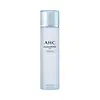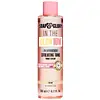What's inside
What's inside
 Key Ingredients
Key Ingredients

 Benefits
Benefits

 Concerns
Concerns

 Ingredients Side-by-side
Ingredients Side-by-side

Water
Skin ConditioningDipropylene Glycol
HumectantGlycerin
HumectantBetaine
Humectant1,2-Hexanediol
Skin ConditioningNiacinamide
SmoothingPropanediol
SolventAlcohol Denat.
AntimicrobialGlycereth-26
HumectantButylene Glycol
HumectantEnteromorpha Compressa Extract
Skin ProtectingCodium Tomentosum Extract
Skin ProtectingUndaria Pinnatifida Extract
Skin ConditioningGlycereth-25 PCA Isostearate
EmulsifyingArtemisia Princeps Leaf Extract
Skin ConditioningEthylhexylglycerin
Skin ConditioningMaris Aqua
HumectantParfum
MaskingAdenosine
Skin ConditioningAmmonium Acryloyldimethyltaurate/Vp Copolymer
Disodium EDTA
Biosaccharide Gum-1
HumectantSodium Hyaluronate
HumectantRosa Damascena Flower Water
MaskingBetula Alba Juice
AstringentCaprylic/Capric Triglyceride
MaskingHydrogenated Lecithin
EmulsifyingButyrospermum Parkii Butter
Skin ConditioningCamellia Sinensis Leaf Water
MaskingCeramide NP
Skin ConditioningCaprylyl Glycol
EmollientAnthemis Nobilis Flower Water
MaskingDaucus Carota Sativa Root Water
MaskingChamaecyparis Obtusa Water
MaskingThuja Orientalis Extract
AntimicrobialCitrus Unshiu Peel Extract
MaskingVitis Vinifera Fruit Water
Skin ConditioningOryza Sativa Bran Water
MaskingPrunus Mume Fruit Water
HumectantCeramide Ns
Skin ConditioningCeramide As
Skin ConditioningCeramide AP
Skin ConditioningCholesterol
EmollientEucalyptus Globulus Leaf Extract
PerfumingPhytosphingosine
Skin ConditioningAsiatic Acid
Skin ConditioningMadecassic Acid
Skin ConditioningAsiaticoside
AntioxidantCeramide EOP
Skin ConditioningWater, Dipropylene Glycol, Glycerin, Betaine, 1,2-Hexanediol, Niacinamide, Propanediol, Alcohol Denat., Glycereth-26, Butylene Glycol, Enteromorpha Compressa Extract, Codium Tomentosum Extract, Undaria Pinnatifida Extract, Glycereth-25 PCA Isostearate, Artemisia Princeps Leaf Extract, Ethylhexylglycerin, Maris Aqua, Parfum, Adenosine, Ammonium Acryloyldimethyltaurate/Vp Copolymer, Disodium EDTA, Biosaccharide Gum-1, Sodium Hyaluronate, Rosa Damascena Flower Water, Betula Alba Juice, Caprylic/Capric Triglyceride, Hydrogenated Lecithin, Butyrospermum Parkii Butter, Camellia Sinensis Leaf Water, Ceramide NP, Caprylyl Glycol, Anthemis Nobilis Flower Water, Daucus Carota Sativa Root Water, Chamaecyparis Obtusa Water, Thuja Orientalis Extract, Citrus Unshiu Peel Extract, Vitis Vinifera Fruit Water, Oryza Sativa Bran Water, Prunus Mume Fruit Water, Ceramide Ns, Ceramide As, Ceramide AP, Cholesterol, Eucalyptus Globulus Leaf Extract, Phytosphingosine, Asiatic Acid, Madecassic Acid, Asiaticoside, Ceramide EOP
Water
Skin ConditioningGlycolic Acid
BufferingButylene Glycol
HumectantGlycerin
HumectantPolysorbate 20
EmulsifyingSodium Hydroxide
BufferingPhenoxyethanol
PreservativePanthenol
Skin ConditioningPEG-40 Hydrogenated Castor Oil
EmulsifyingPPG-26-Buteth-26
Skin ConditioningBisabolol
MaskingEthylhexylglycerin
Skin ConditioningParfum
MaskingChamomilla Recutita Flower Extract
MaskingDipropylene Glycol
HumectantCitrus Aurantium Amara Flower Extract
RefreshingPotassium Sorbate
PreservativeSodium Benzoate
MaskingLimonene
PerfumingWater, Glycolic Acid, Butylene Glycol, Glycerin, Polysorbate 20, Sodium Hydroxide, Phenoxyethanol, Panthenol, PEG-40 Hydrogenated Castor Oil, PPG-26-Buteth-26, Bisabolol, Ethylhexylglycerin, Parfum, Chamomilla Recutita Flower Extract, Dipropylene Glycol, Citrus Aurantium Amara Flower Extract, Potassium Sorbate, Sodium Benzoate, Limonene
Ingredients Explained
These ingredients are found in both products.
Ingredients higher up in an ingredient list are typically present in a larger amount.
Butylene Glycol (or BG) is used within cosmetic products for a few different reasons:
Overall, Butylene Glycol is a safe and well-rounded ingredient that works well with other ingredients.
Though this ingredient works well with most skin types, some people with sensitive skin may experience a reaction such as allergic rashes, closed comedones, or itchiness.
Learn more about Butylene GlycolDipropylene Glycol is a synthetically created humectant, stabilizer, and solvent.
This ingredient helps:
Dipropylene glycol is technically an alcohol, but it belongs to the glycol family (often considered part of the ‘good’ alcohols). This means it is hydrating and gentle on skin unlike drying solvent alcohols like denatured alcohol.
As a masking agent, Dipropylene Glycol can be used to cover the smell of other ingredients. However, it does not have a scent.
Studies show Dipropylene Glycol is considered safe to use in skincare.
Learn more about Dipropylene GlycolEthylhexylglycerin (we can't pronounce this either) is commonly used as a preservative and skin softener. It is derived from glyceryl.
You might see Ethylhexylglycerin often paired with other preservatives such as phenoxyethanol. Ethylhexylglycerin has been found to increase the effectiveness of these other preservatives.
Glycerin is already naturally found in your skin. It helps moisturize and protect your skin.
A study from 2016 found glycerin to be more effective as a humectant than AHAs and hyaluronic acid.
As a humectant, it helps the skin stay hydrated by pulling moisture to your skin. The low molecular weight of glycerin allows it to pull moisture into the deeper layers of your skin.
Hydrated skin improves your skin barrier; Your skin barrier helps protect against irritants and bacteria.
Glycerin has also been found to have antimicrobial and antiviral properties. Due to these properties, glycerin is often used in wound and burn treatments.
In cosmetics, glycerin is usually derived from plants such as soybean or palm. However, it can also be sourced from animals, such as tallow or animal fat.
This ingredient is organic, colorless, odorless, and non-toxic.
Glycerin is the name for this ingredient in American English. British English uses Glycerol/Glycerine.
Learn more about GlycerinParfum is a catch-all term for an ingredient or more that is used to give a scent to products.
Also called "fragrance", this ingredient can be a blend of hundreds of chemicals or plant oils. This means every product with "fragrance" or "parfum" in the ingredients list is a different mixture.
For instance, Habanolide is a proprietary trade name for a specific aroma chemical. When used as a fragrance ingredient in cosmetics, most aroma chemicals fall under the broad labeling category of “FRAGRANCE” or “PARFUM” according to EU and US regulations.
The term 'parfum' or 'fragrance' is not regulated in many countries. In many cases, it is up to the brand to define this term.
For instance, many brands choose to label themselves as "fragrance-free" because they are not using synthetic fragrances. However, their products may still contain ingredients such as essential oils that are considered a fragrance by INCI standards.
One example is Calendula flower extract. Calendula is an essential oil that still imparts a scent or 'fragrance'.
Depending on the blend, the ingredients in the mixture can cause allergies and sensitivities on the skin. Some ingredients that are known EU allergens include linalool and citronellol.
Parfum can also be used to mask or cover an unpleasant scent.
The bottom line is: not all fragrances/parfum/ingredients are created equally. If you are worried about fragrances, we recommend taking a closer look at an ingredient. And of course, we always recommend speaking with a professional.
Learn more about ParfumWater. It's the most common cosmetic ingredient of all. You'll usually see it at the top of ingredient lists, meaning that it makes up the largest part of the product.
So why is it so popular? Water most often acts as a solvent - this means that it helps dissolve other ingredients into the formulation.
You'll also recognize water as that liquid we all need to stay alive. If you see this, drink a glass of water. Stay hydrated!
Learn more about Water